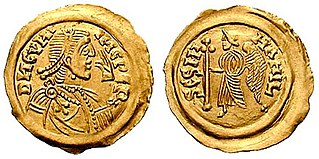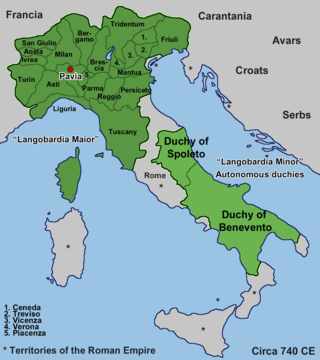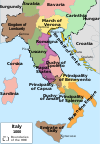The 700s decade ran from January 1, 700, to December 31, 709.

Year 701 (DCCI) was a common year starting on Saturday of the Julian calendar, the 701st year of the Common Era (CE) and Anno Domini (AD) designations, the 701st year of the 1st millennium, the 1st year of the 8th century, and the 2nd year of the 700s decade. The denomination 701 for this year has been used since the early medieval period, when the Anno Domini calendar era became the prevalent method in Europe for naming years.

King of Italy was the title given to the ruler of the Kingdom of Italy after the fall of the Western Roman Empire. The first to take the title was Odoacer, a barbarian military leader, in the late 5th century, followed by the Ostrogothic kings up to the mid-6th century. With the Frankish conquest of Italy in the 8th century, the Carolingians assumed the title, which was maintained by subsequent Holy Roman Emperors throughout the Middle Ages. The last Emperor to claim the title was Charles V in the 16th century. During this period, the holders of the title were crowned with the Iron Crown of Lombardy.

The Agilolfings were a noble family that ruled the Duchy of Bavaria on behalf of their Merovingian suzerains from about 550 until 788. A cadet branch of the Agilolfings also ruled the Kingdom of the Lombards intermittently from 616 to 712. They are mentioned as the leading dynasty in the Lex Baiuvariorum. Their Bavarian residence was at Regensburg.
Cleph was king of the Lombards from 572 to 574.

Rothari, of the house of Arodus, was king of the Lombards from 636 to 652; previously he had been duke of Brescia. He succeeded Arioald, who was an Arian like himself, and was one of the most energetic of Lombard kings. Fredegar relates that at the beginning of his reign he put to death many insubordinate nobles, and that in his efforts for peace he maintained very strict discipline.
Arioald was the Lombard king of Italy from 626 to 636. Duke of Turin, he married the princess Gundeberga, daughter of King Agilulf and his queen Theodelinda. He was, unlike his father-in-law, an Arian who did not accept Catholicism.

Aripert I was king of the Lombards (653–661) in Italy. He was the son of Gundoald, Duke of Asti, who had crossed the Alps from Bavaria with his sister Theodelinda. As a relative of the Bavarian ducal house, his was called the Bavarian Dynasty.

Ansprand was king of the Lombards briefly in 712. Before that, he was the duke of Asti and regent during the minority of Liutpert (700–701). He was defeated at Novara by Raginpert and exiled during the subsequent war over the succession, fleeing to the court of Theudebert, duke of Bavaria, in 702.

Aripert II was the king of the Lombards from 701 to 712. Duke of Turin and son of King Raginpert, and thus a scion of the Bavarian Dynasty, he was associated with the throne as early as 700. He was removed by Liutpert, who reigned from 700 to 702, with the exception of the year 701, when Raginpert seized the throne. After his father's death, he tried to take the throne, too. He defeated Liutpert and the regent Ansprand's men at Pavia and captured the king, whom he later had strangled in his bath. He seized the capital and forced Ansprand over the Alps. He was firmly in power by 703.
Godepert was king of the Lombards, eldest son and successor of Aripert I. He was an Arian who governed from the ancient capital, Pavia, while his brother, Perctarit, a Roman Catholic, governed from Milan. In a war with his brother, he beckoned Duke Grimoald I of Benevento, who assassinated him in his Pavian palace, the Reggia. Godepert's son Raginpert managed to escape and would later rule, but first, Grimoald would seize the throne. He was buried in the Basilica of Santissimo Salvatore in Pavia.

Perctarit was king of the Lombards from 661 to 662 the first time and later from 671 to 688.

Cunipert was king of the Lombards from 688 to 700. He succeeded his father Perctarit, though he was associated with the throne from 680.
Raginpert was the Duke of Turin and then King of the Lombards briefly in 701. He was the son of Godepert and grandson of Aripert I. He usurped the throne in 701 and removed Liutpert, his grandnephew, putting his son Aripert in line for the succession. He and his Neustrians went out to meet the regent, Ansprand, in battle and defeated him at Novara, but died shortly after. His son Aripert did not succeed in taking the throne right away.
Grimoald or Grimwald (†671) was a 7th-century King of Italy, ruling as Duke of Benevento from 647 to 662, and then as King of the Lombards from 662 until his death in 671.
Garibald was the young son of Grimoald I of Benevento, king of the Lombards, and Theodota, daughter of Aripert I. After his father's death in 671, he reigned briefly for three months until the numerous adherents of Perctarit, his uncle, who had been exiled by Grimoald nine years earlier, besought their candidate to return and elected him, deposing the young king. He was the last Arian king in Europe.

The Kingdom of the Lombards, also known as the Lombard Kingdom and later as the Kingdom of all Italy, was an early medieval state established by the Lombards, a Germanic people, on the Italian Peninsula in the latter part of the 6th century. The king was traditionally elected by the very highest-ranking aristocrats, the dukes, as several attempts to establish a hereditary dynasty failed. The kingdom was subdivided into a varying number of duchies, ruled by semi-autonomous dukes, which were in turn subdivided into gastaldates at the municipal level. The capital of the kingdom and the center of its political life was Pavia in the modern northern Italian region of Lombardy.
Ado was the Duke of Friuli after the usurper Ausfrid was defeated at Verona in 694. According to Paul the Deacon, he was a brother of the former duke Rodoald and ruled for a year and seven months. The actual length of his reign is disputed, as is the year of its occurrence. He appears with the title loci servator (caretaker) and may have only held the duchy as regent on behalf of the king.
Rotarit was a Lombard duke, the last Duke of Bergamo.











